HI6028 Taxation Law: Capital Gains Tax and Income Analysis - HI
VerifiedAdded on 2023/03/31
|11
|2159
|340
Homework Assignment
AI Summary
This assignment delves into various aspects of taxation law, specifically focusing on Capital Gains Tax (CGT) implications and the assessment of income. It analyzes scenarios involving the sale of assets, including collectibles, and their impact on taxable income. The assignment also examines the treatment of payments received for writing a book and the effects of financial arrangements between family members on assessable income. The discussions are supported by references to relevant sections of the Income Tax Assessment Act and case law, providing a comprehensive understanding of the legal principles involved. Desklib offers a wealth of resources, including past papers and solved assignments, to aid students in their studies.
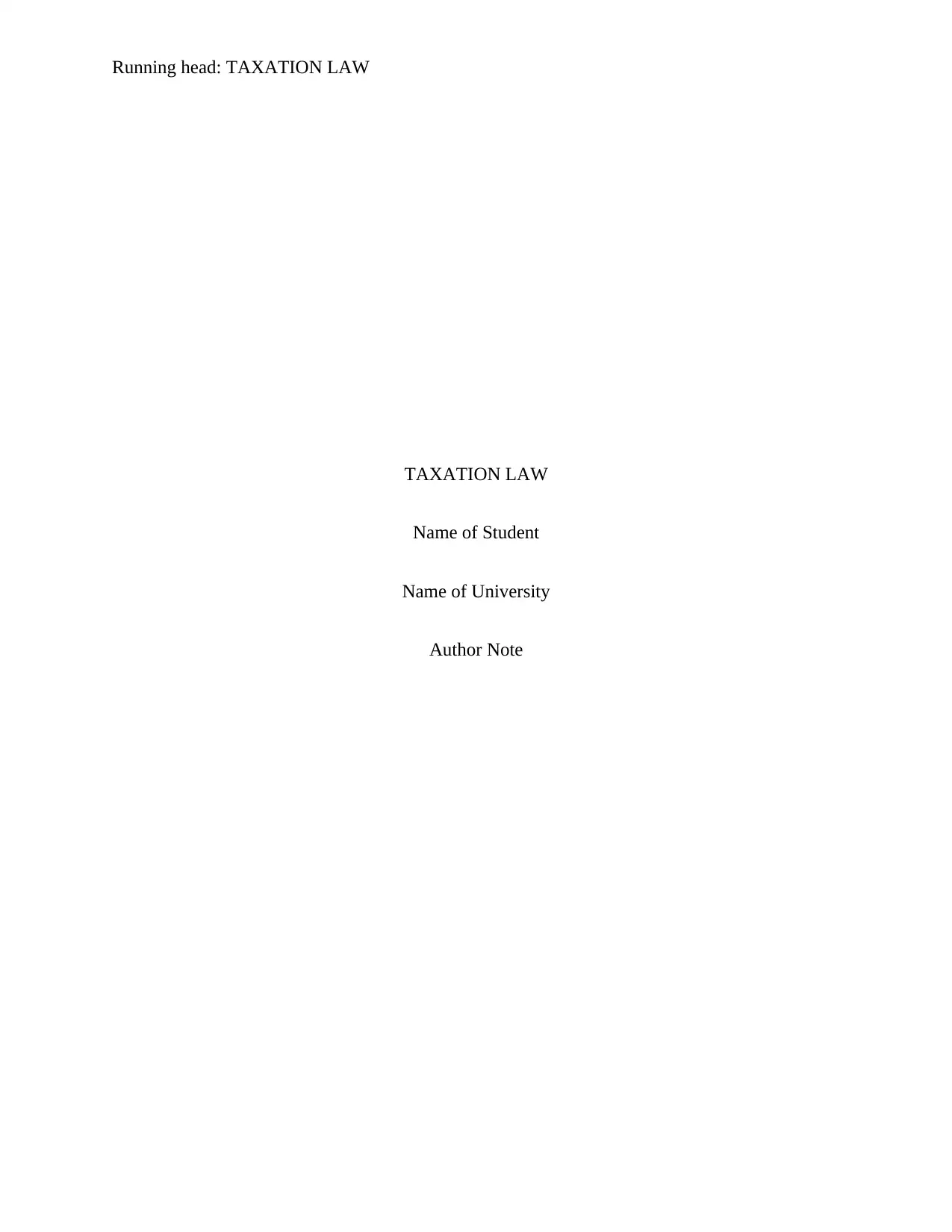
Running head: TAXATION LAW
TAXATION LAW
Name of Student
Name of University
Author Note
TAXATION LAW
Name of Student
Name of University
Author Note
Paraphrase This Document
Need a fresh take? Get an instant paraphrase of this document with our AI Paraphraser
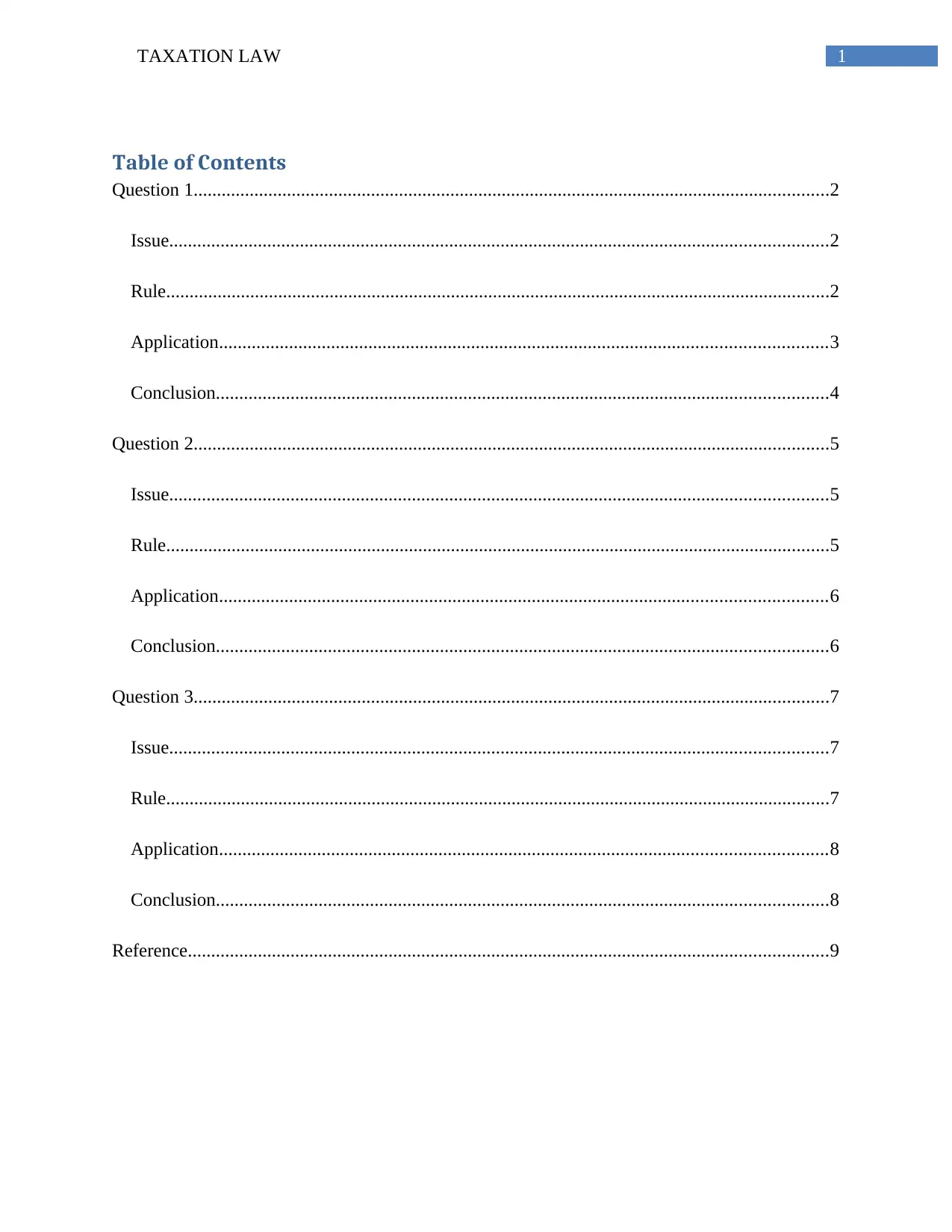
1TAXATION LAW
Table of Contents
Question 1........................................................................................................................................2
Issue.............................................................................................................................................2
Rule..............................................................................................................................................2
Application..................................................................................................................................3
Conclusion...................................................................................................................................4
Question 2........................................................................................................................................5
Issue.............................................................................................................................................5
Rule..............................................................................................................................................5
Application..................................................................................................................................6
Conclusion...................................................................................................................................6
Question 3........................................................................................................................................7
Issue.............................................................................................................................................7
Rule..............................................................................................................................................7
Application..................................................................................................................................8
Conclusion...................................................................................................................................8
Reference.........................................................................................................................................9
Table of Contents
Question 1........................................................................................................................................2
Issue.............................................................................................................................................2
Rule..............................................................................................................................................2
Application..................................................................................................................................3
Conclusion...................................................................................................................................4
Question 2........................................................................................................................................5
Issue.............................................................................................................................................5
Rule..............................................................................................................................................5
Application..................................................................................................................................6
Conclusion...................................................................................................................................6
Question 3........................................................................................................................................7
Issue.............................................................................................................................................7
Rule..............................................................................................................................................7
Application..................................................................................................................................8
Conclusion...................................................................................................................................8
Reference.........................................................................................................................................9
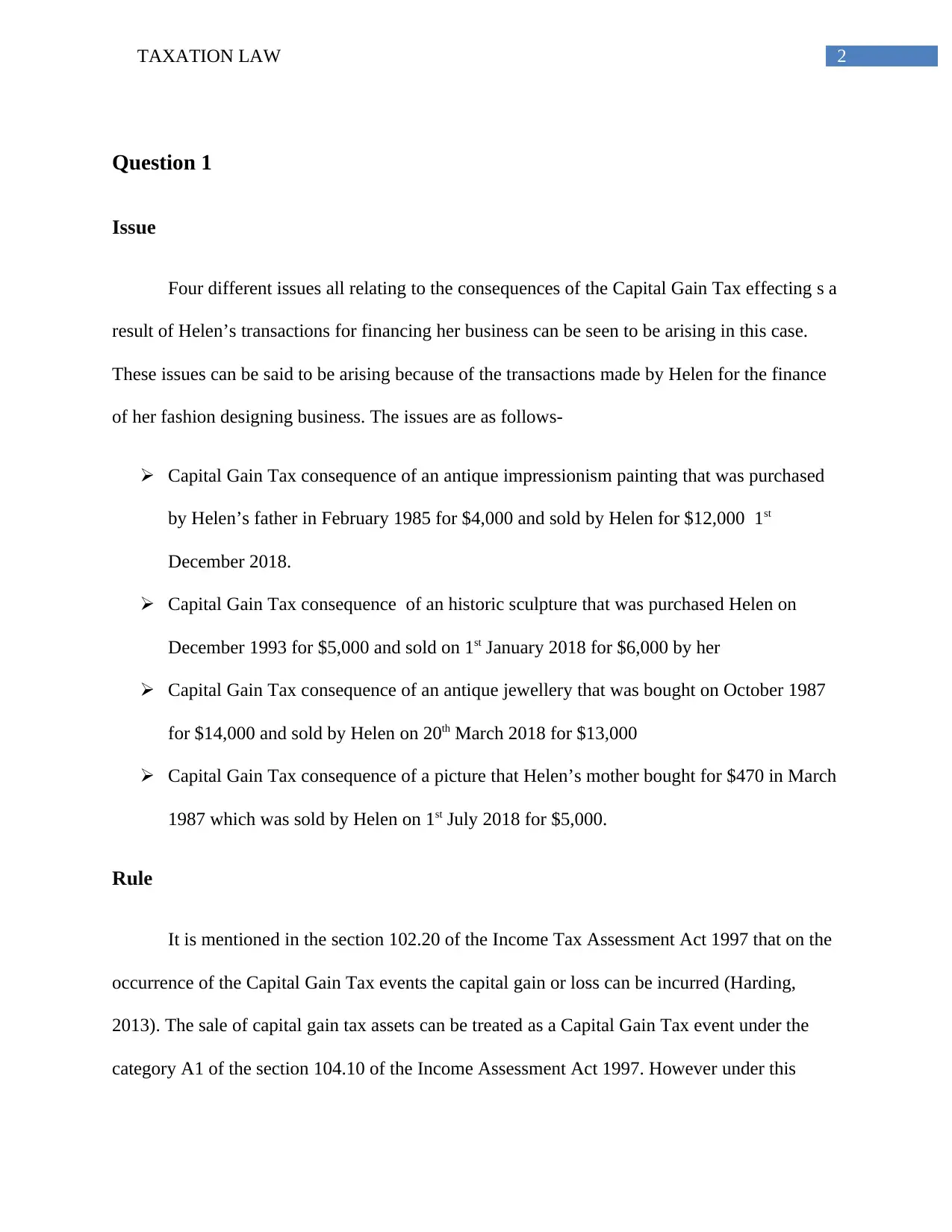
2TAXATION LAW
Question 1
Issue
Four different issues all relating to the consequences of the Capital Gain Tax effecting s a
result of Helen’s transactions for financing her business can be seen to be arising in this case.
These issues can be said to be arising because of the transactions made by Helen for the finance
of her fashion designing business. The issues are as follows-
Capital Gain Tax consequence of an antique impressionism painting that was purchased
by Helen’s father in February 1985 for $4,000 and sold by Helen for $12,000 1st
December 2018.
Capital Gain Tax consequence of an historic sculpture that was purchased Helen on
December 1993 for $5,000 and sold on 1st January 2018 for $6,000 by her
Capital Gain Tax consequence of an antique jewellery that was bought on October 1987
for $14,000 and sold by Helen on 20th March 2018 for $13,000
Capital Gain Tax consequence of a picture that Helen’s mother bought for $470 in March
1987 which was sold by Helen on 1st July 2018 for $5,000.
Rule
It is mentioned in the section 102.20 of the Income Tax Assessment Act 1997 that on the
occurrence of the Capital Gain Tax events the capital gain or loss can be incurred (Harding,
2013). The sale of capital gain tax assets can be treated as a Capital Gain Tax event under the
category A1 of the section 104.10 of the Income Assessment Act 1997. However under this
Question 1
Issue
Four different issues all relating to the consequences of the Capital Gain Tax effecting s a
result of Helen’s transactions for financing her business can be seen to be arising in this case.
These issues can be said to be arising because of the transactions made by Helen for the finance
of her fashion designing business. The issues are as follows-
Capital Gain Tax consequence of an antique impressionism painting that was purchased
by Helen’s father in February 1985 for $4,000 and sold by Helen for $12,000 1st
December 2018.
Capital Gain Tax consequence of an historic sculpture that was purchased Helen on
December 1993 for $5,000 and sold on 1st January 2018 for $6,000 by her
Capital Gain Tax consequence of an antique jewellery that was bought on October 1987
for $14,000 and sold by Helen on 20th March 2018 for $13,000
Capital Gain Tax consequence of a picture that Helen’s mother bought for $470 in March
1987 which was sold by Helen on 1st July 2018 for $5,000.
Rule
It is mentioned in the section 102.20 of the Income Tax Assessment Act 1997 that on the
occurrence of the Capital Gain Tax events the capital gain or loss can be incurred (Harding,
2013). The sale of capital gain tax assets can be treated as a Capital Gain Tax event under the
category A1 of the section 104.10 of the Income Assessment Act 1997. However under this
⊘ This is a preview!⊘
Do you want full access?
Subscribe today to unlock all pages.

Trusted by 1+ million students worldwide
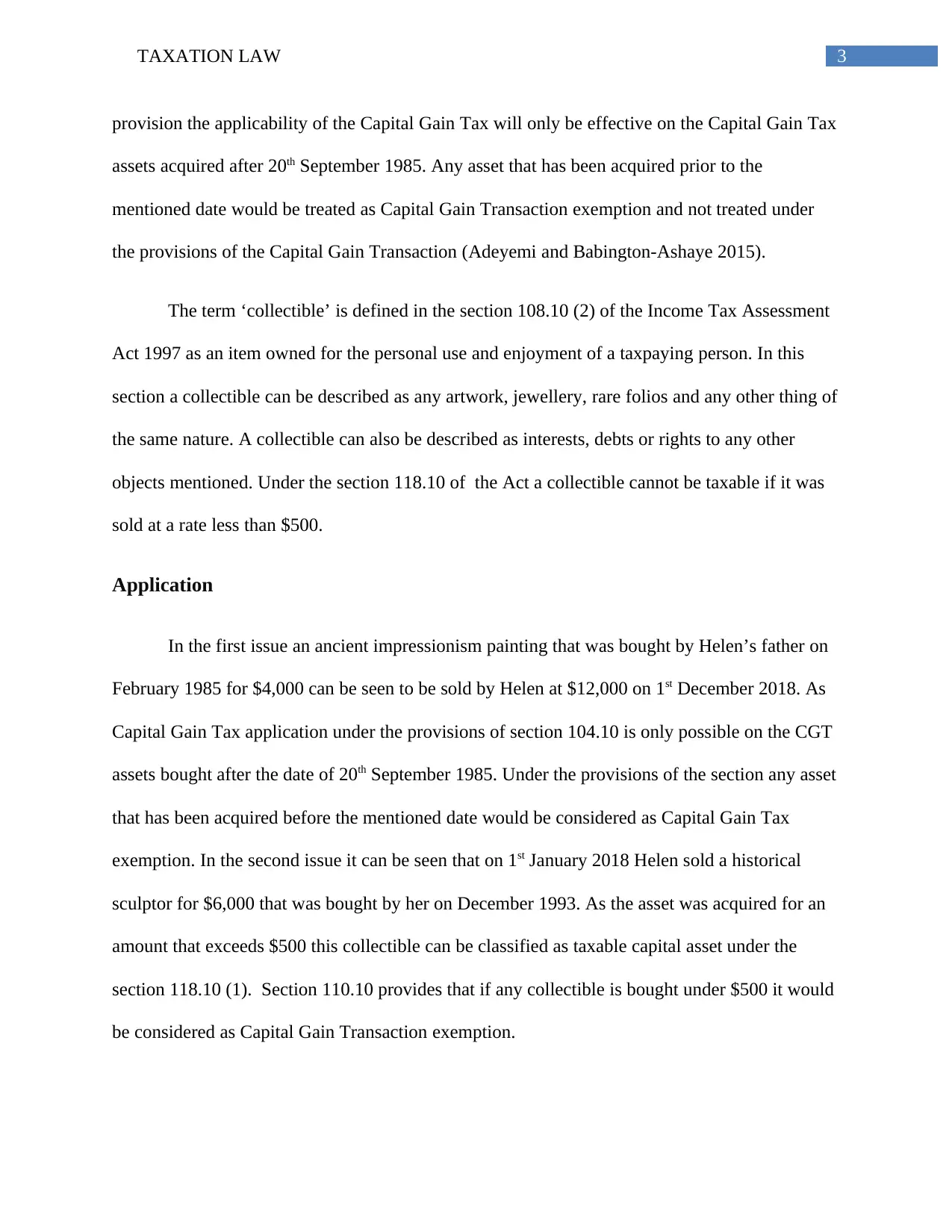
3TAXATION LAW
provision the applicability of the Capital Gain Tax will only be effective on the Capital Gain Tax
assets acquired after 20th September 1985. Any asset that has been acquired prior to the
mentioned date would be treated as Capital Gain Transaction exemption and not treated under
the provisions of the Capital Gain Transaction (Adeyemi and Babington-Ashaye 2015).
The term ‘collectible’ is defined in the section 108.10 (2) of the Income Tax Assessment
Act 1997 as an item owned for the personal use and enjoyment of a taxpaying person. In this
section a collectible can be described as any artwork, jewellery, rare folios and any other thing of
the same nature. A collectible can also be described as interests, debts or rights to any other
objects mentioned. Under the section 118.10 of the Act a collectible cannot be taxable if it was
sold at a rate less than $500.
Application
In the first issue an ancient impressionism painting that was bought by Helen’s father on
February 1985 for $4,000 can be seen to be sold by Helen at $12,000 on 1st December 2018. As
Capital Gain Tax application under the provisions of section 104.10 is only possible on the CGT
assets bought after the date of 20th September 1985. Under the provisions of the section any asset
that has been acquired before the mentioned date would be considered as Capital Gain Tax
exemption. In the second issue it can be seen that on 1st January 2018 Helen sold a historical
sculptor for $6,000 that was bought by her on December 1993. As the asset was acquired for an
amount that exceeds $500 this collectible can be classified as taxable capital asset under the
section 118.10 (1). Section 110.10 provides that if any collectible is bought under $500 it would
be considered as Capital Gain Transaction exemption.
provision the applicability of the Capital Gain Tax will only be effective on the Capital Gain Tax
assets acquired after 20th September 1985. Any asset that has been acquired prior to the
mentioned date would be treated as Capital Gain Transaction exemption and not treated under
the provisions of the Capital Gain Transaction (Adeyemi and Babington-Ashaye 2015).
The term ‘collectible’ is defined in the section 108.10 (2) of the Income Tax Assessment
Act 1997 as an item owned for the personal use and enjoyment of a taxpaying person. In this
section a collectible can be described as any artwork, jewellery, rare folios and any other thing of
the same nature. A collectible can also be described as interests, debts or rights to any other
objects mentioned. Under the section 118.10 of the Act a collectible cannot be taxable if it was
sold at a rate less than $500.
Application
In the first issue an ancient impressionism painting that was bought by Helen’s father on
February 1985 for $4,000 can be seen to be sold by Helen at $12,000 on 1st December 2018. As
Capital Gain Tax application under the provisions of section 104.10 is only possible on the CGT
assets bought after the date of 20th September 1985. Under the provisions of the section any asset
that has been acquired before the mentioned date would be considered as Capital Gain Tax
exemption. In the second issue it can be seen that on 1st January 2018 Helen sold a historical
sculptor for $6,000 that was bought by her on December 1993. As the asset was acquired for an
amount that exceeds $500 this collectible can be classified as taxable capital asset under the
section 118.10 (1). Section 110.10 provides that if any collectible is bought under $500 it would
be considered as Capital Gain Transaction exemption.
Paraphrase This Document
Need a fresh take? Get an instant paraphrase of this document with our AI Paraphraser

4TAXATION LAW
In the third issue Helen can be seen to sell an antique jewellery that was bought for
$14,000 on October 1987 for $13,000 on 20th March 2018. This issue can be seen to be relating
to the provisions of section 108.10 of the Act. Section 108.10 provides that for a CGT loss
incurred by the sale of a collectible can only be compensated by CGT gain accrued by the sale of
any other collectible. The CGT loss by way of sale of collectible cannot be treated in offset with
any other Capital Gain Tax gain under this section. In this case the CGT gain from the sculpture
sale can be treated in offset with the CGT loss of the jewellery sale.
The fourth issue deals with the sale of the picture for $5000 on 1st July 2018 that was
purchased by Helen’s mother for $470 on March 1987. Under the provisions of the section
108.20of the Act the picture can be regarded as asset that has been utilized for personal purpose.
If the value of a Capital Gain Tax asset does not exceed $10,000 under this section would be
considered to be a CGT asset for personal usage and would be exempted from tax.
Conclusion
Thus from the above discussions regarding the transactions of Helen it can be said in
conclusion that-
The sale of the antique impressionism painting that belonged to Helen’s Father for
$12,000 can be considered as a Capital Gain Tax exemption.
The sale of the historical sculpture for $6,000 can be considered as taxable capital asset.
The CGT loss on sale of antique jewellery will be needed to be considered with CGT
gain accrued on another collectible’s sale, in this case CGT gain of the sculptor.
Finally as the cost of the picture is less than $10,000 it is needed to be treated as CGT
asset that has been used for personal purpose.
In the third issue Helen can be seen to sell an antique jewellery that was bought for
$14,000 on October 1987 for $13,000 on 20th March 2018. This issue can be seen to be relating
to the provisions of section 108.10 of the Act. Section 108.10 provides that for a CGT loss
incurred by the sale of a collectible can only be compensated by CGT gain accrued by the sale of
any other collectible. The CGT loss by way of sale of collectible cannot be treated in offset with
any other Capital Gain Tax gain under this section. In this case the CGT gain from the sculpture
sale can be treated in offset with the CGT loss of the jewellery sale.
The fourth issue deals with the sale of the picture for $5000 on 1st July 2018 that was
purchased by Helen’s mother for $470 on March 1987. Under the provisions of the section
108.20of the Act the picture can be regarded as asset that has been utilized for personal purpose.
If the value of a Capital Gain Tax asset does not exceed $10,000 under this section would be
considered to be a CGT asset for personal usage and would be exempted from tax.
Conclusion
Thus from the above discussions regarding the transactions of Helen it can be said in
conclusion that-
The sale of the antique impressionism painting that belonged to Helen’s Father for
$12,000 can be considered as a Capital Gain Tax exemption.
The sale of the historical sculpture for $6,000 can be considered as taxable capital asset.
The CGT loss on sale of antique jewellery will be needed to be considered with CGT
gain accrued on another collectible’s sale, in this case CGT gain of the sculptor.
Finally as the cost of the picture is less than $10,000 it is needed to be treated as CGT
asset that has been used for personal purpose.

5TAXATION LAW
Question 2
Issue
In this case the primary issue that can be found is whether the payments received by
Barbara are qualified for regarding them as incomes from her personal exertion. The second
issue that can be found in this case whether there would be any difference if the book was
written by Barbara before going into contract with the Eco Books Ltd.
Rule
In the interpretation clause under section 6 of the Income Tax Assessment Act 1936
income derived from personal exertion is seen to be defined. This definition can be seen to be
including incomes like salary, wages, fees, commissions and other earnings by any employee.
This section further includes the revenues received by a tax payer in conducting business alone
or in partnership. The assessable income of a taxpayer is also included in this section. For an
income to be under this section’s scope it must be established that there is a close relation
between the taxpayer and his personal exertion (Tran 2015). This issue has been observed in the
case Blank v Federal Commissioner of Taxation [2015].
Section 6.5 of the Income Tax Assessment Act 1997 defines an ordinary income as the
income earned by a person by providing any effort or service. In Australia, a person’s assessable
income can be seen to be comprising of ordinary income that has been directly or indirectly
derived from various sources in a income year by working either inside or outside of the country.
Question 2
Issue
In this case the primary issue that can be found is whether the payments received by
Barbara are qualified for regarding them as incomes from her personal exertion. The second
issue that can be found in this case whether there would be any difference if the book was
written by Barbara before going into contract with the Eco Books Ltd.
Rule
In the interpretation clause under section 6 of the Income Tax Assessment Act 1936
income derived from personal exertion is seen to be defined. This definition can be seen to be
including incomes like salary, wages, fees, commissions and other earnings by any employee.
This section further includes the revenues received by a tax payer in conducting business alone
or in partnership. The assessable income of a taxpayer is also included in this section. For an
income to be under this section’s scope it must be established that there is a close relation
between the taxpayer and his personal exertion (Tran 2015). This issue has been observed in the
case Blank v Federal Commissioner of Taxation [2015].
Section 6.5 of the Income Tax Assessment Act 1997 defines an ordinary income as the
income earned by a person by providing any effort or service. In Australia, a person’s assessable
income can be seen to be comprising of ordinary income that has been directly or indirectly
derived from various sources in a income year by working either inside or outside of the country.
⊘ This is a preview!⊘
Do you want full access?
Subscribe today to unlock all pages.

Trusted by 1+ million students worldwide
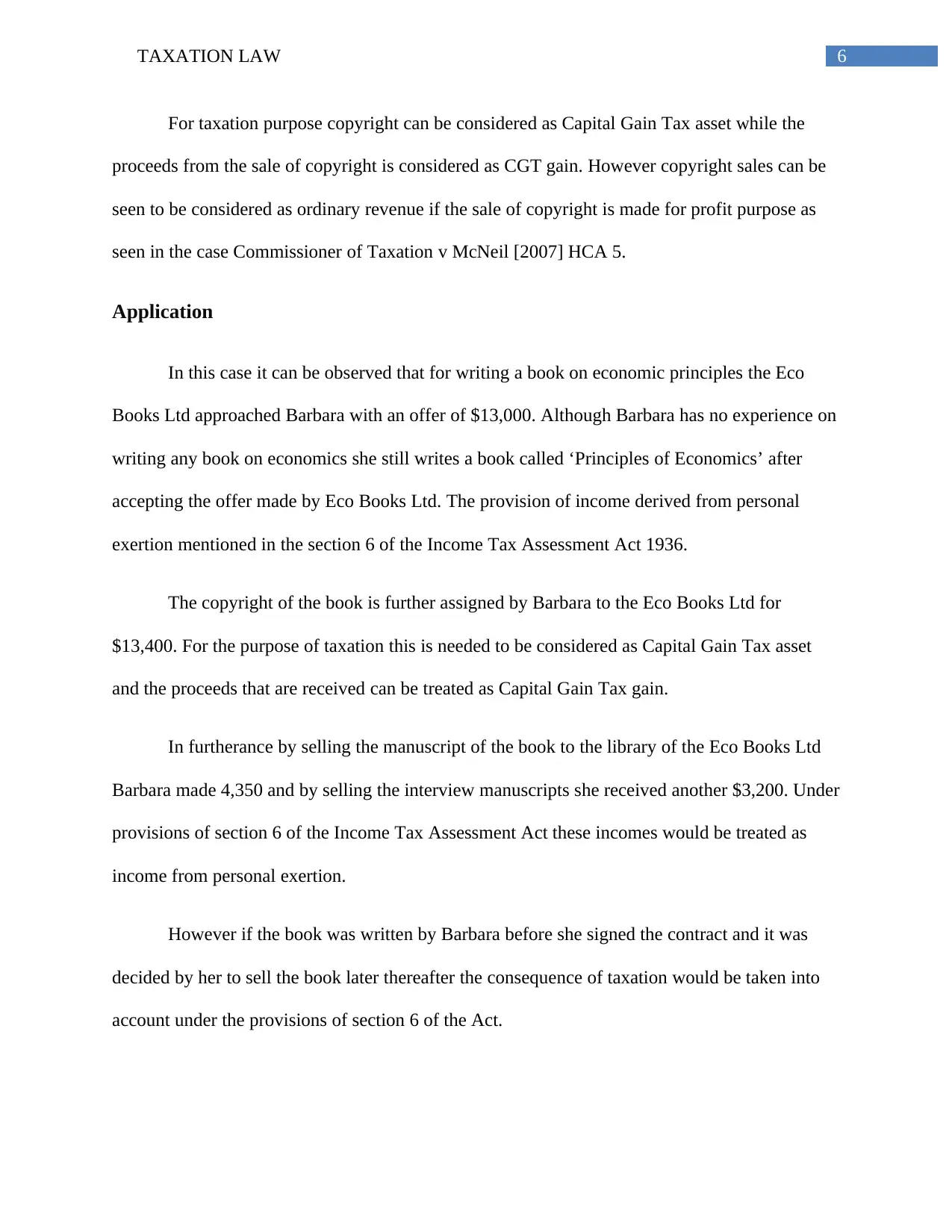
6TAXATION LAW
For taxation purpose copyright can be considered as Capital Gain Tax asset while the
proceeds from the sale of copyright is considered as CGT gain. However copyright sales can be
seen to be considered as ordinary revenue if the sale of copyright is made for profit purpose as
seen in the case Commissioner of Taxation v McNeil [2007] HCA 5.
Application
In this case it can be observed that for writing a book on economic principles the Eco
Books Ltd approached Barbara with an offer of $13,000. Although Barbara has no experience on
writing any book on economics she still writes a book called ‘Principles of Economics’ after
accepting the offer made by Eco Books Ltd. The provision of income derived from personal
exertion mentioned in the section 6 of the Income Tax Assessment Act 1936.
The copyright of the book is further assigned by Barbara to the Eco Books Ltd for
$13,400. For the purpose of taxation this is needed to be considered as Capital Gain Tax asset
and the proceeds that are received can be treated as Capital Gain Tax gain.
In furtherance by selling the manuscript of the book to the library of the Eco Books Ltd
Barbara made 4,350 and by selling the interview manuscripts she received another $3,200. Under
provisions of section 6 of the Income Tax Assessment Act these incomes would be treated as
income from personal exertion.
However if the book was written by Barbara before she signed the contract and it was
decided by her to sell the book later thereafter the consequence of taxation would be taken into
account under the provisions of section 6 of the Act.
For taxation purpose copyright can be considered as Capital Gain Tax asset while the
proceeds from the sale of copyright is considered as CGT gain. However copyright sales can be
seen to be considered as ordinary revenue if the sale of copyright is made for profit purpose as
seen in the case Commissioner of Taxation v McNeil [2007] HCA 5.
Application
In this case it can be observed that for writing a book on economic principles the Eco
Books Ltd approached Barbara with an offer of $13,000. Although Barbara has no experience on
writing any book on economics she still writes a book called ‘Principles of Economics’ after
accepting the offer made by Eco Books Ltd. The provision of income derived from personal
exertion mentioned in the section 6 of the Income Tax Assessment Act 1936.
The copyright of the book is further assigned by Barbara to the Eco Books Ltd for
$13,400. For the purpose of taxation this is needed to be considered as Capital Gain Tax asset
and the proceeds that are received can be treated as Capital Gain Tax gain.
In furtherance by selling the manuscript of the book to the library of the Eco Books Ltd
Barbara made 4,350 and by selling the interview manuscripts she received another $3,200. Under
provisions of section 6 of the Income Tax Assessment Act these incomes would be treated as
income from personal exertion.
However if the book was written by Barbara before she signed the contract and it was
decided by her to sell the book later thereafter the consequence of taxation would be taken into
account under the provisions of section 6 of the Act.
Paraphrase This Document
Need a fresh take? Get an instant paraphrase of this document with our AI Paraphraser
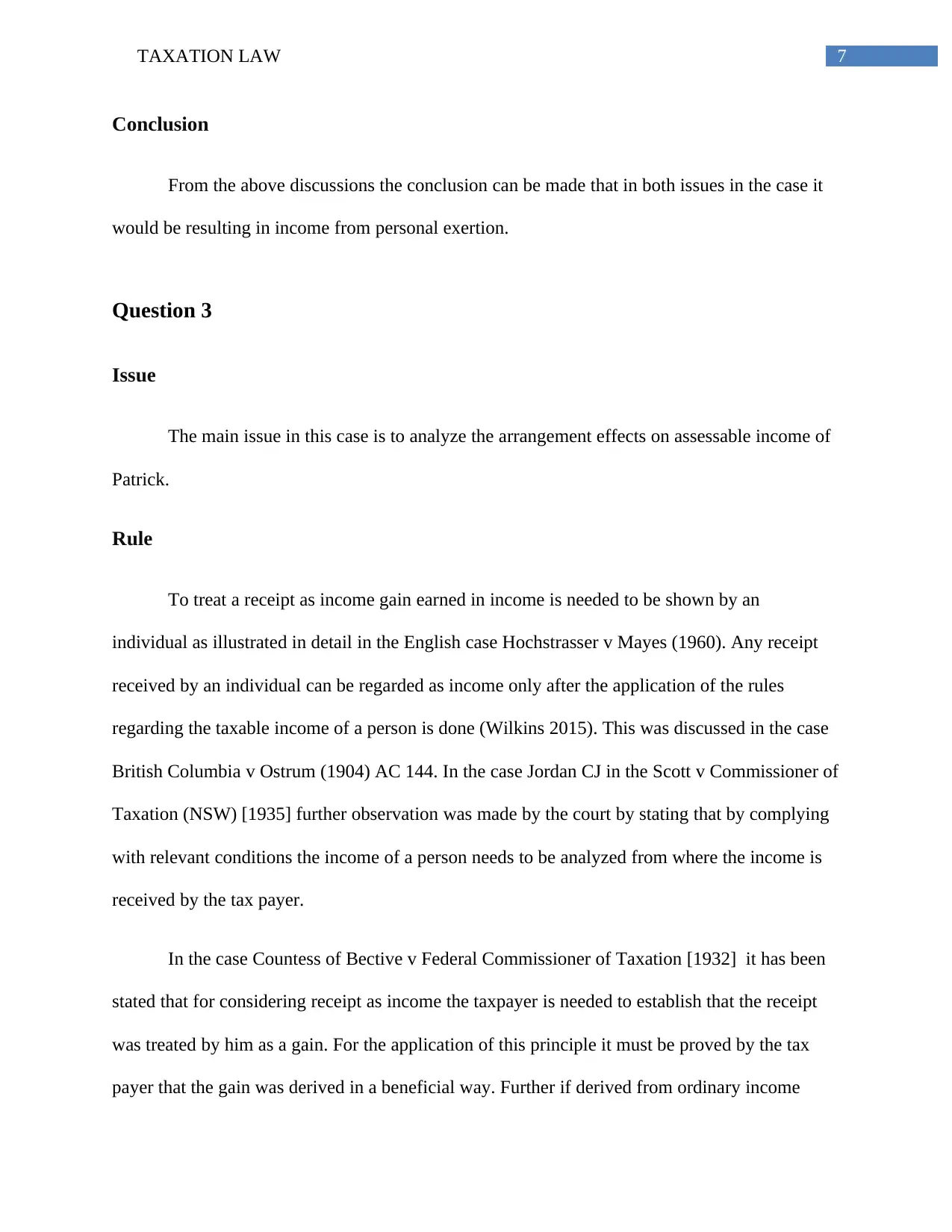
7TAXATION LAW
Conclusion
From the above discussions the conclusion can be made that in both issues in the case it
would be resulting in income from personal exertion.
Question 3
Issue
The main issue in this case is to analyze the arrangement effects on assessable income of
Patrick.
Rule
To treat a receipt as income gain earned in income is needed to be shown by an
individual as illustrated in detail in the English case Hochstrasser v Mayes (1960). Any receipt
received by an individual can be regarded as income only after the application of the rules
regarding the taxable income of a person is done (Wilkins 2015). This was discussed in the case
British Columbia v Ostrum (1904) AC 144. In the case Jordan CJ in the Scott v Commissioner of
Taxation (NSW) [1935] further observation was made by the court by stating that by complying
with relevant conditions the income of a person needs to be analyzed from where the income is
received by the tax payer.
In the case Countess of Bective v Federal Commissioner of Taxation [1932] it has been
stated that for considering receipt as income the taxpayer is needed to establish that the receipt
was treated by him as a gain. For the application of this principle it must be proved by the tax
payer that the gain was derived in a beneficial way. Further if derived from ordinary income
Conclusion
From the above discussions the conclusion can be made that in both issues in the case it
would be resulting in income from personal exertion.
Question 3
Issue
The main issue in this case is to analyze the arrangement effects on assessable income of
Patrick.
Rule
To treat a receipt as income gain earned in income is needed to be shown by an
individual as illustrated in detail in the English case Hochstrasser v Mayes (1960). Any receipt
received by an individual can be regarded as income only after the application of the rules
regarding the taxable income of a person is done (Wilkins 2015). This was discussed in the case
British Columbia v Ostrum (1904) AC 144. In the case Jordan CJ in the Scott v Commissioner of
Taxation (NSW) [1935] further observation was made by the court by stating that by complying
with relevant conditions the income of a person needs to be analyzed from where the income is
received by the tax payer.
In the case Countess of Bective v Federal Commissioner of Taxation [1932] it has been
stated that for considering receipt as income the taxpayer is needed to establish that the receipt
was treated by him as a gain. For the application of this principle it must be proved by the tax
payer that the gain was derived in a beneficial way. Further if derived from ordinary income
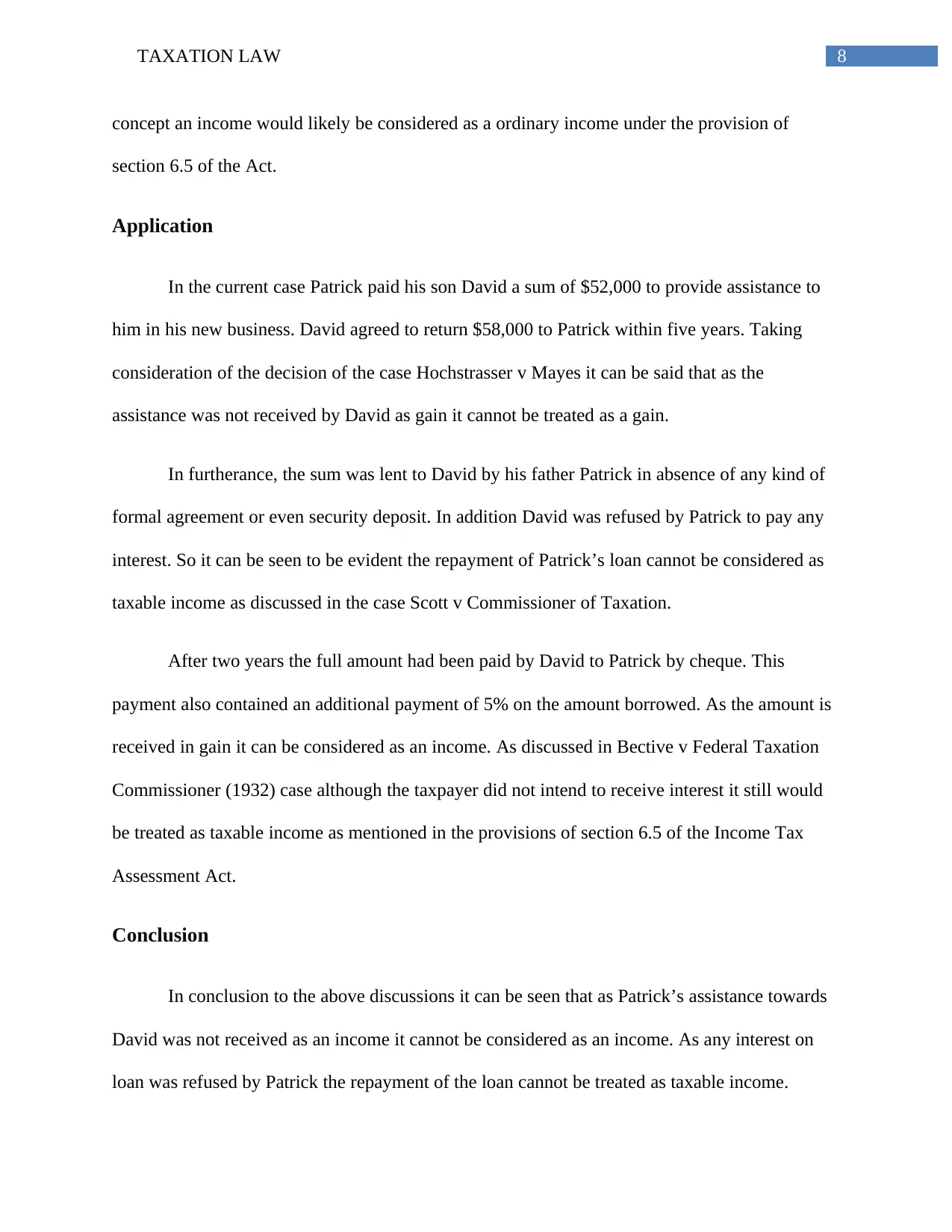
8TAXATION LAW
concept an income would likely be considered as a ordinary income under the provision of
section 6.5 of the Act.
Application
In the current case Patrick paid his son David a sum of $52,000 to provide assistance to
him in his new business. David agreed to return $58,000 to Patrick within five years. Taking
consideration of the decision of the case Hochstrasser v Mayes it can be said that as the
assistance was not received by David as gain it cannot be treated as a gain.
In furtherance, the sum was lent to David by his father Patrick in absence of any kind of
formal agreement or even security deposit. In addition David was refused by Patrick to pay any
interest. So it can be seen to be evident the repayment of Patrick’s loan cannot be considered as
taxable income as discussed in the case Scott v Commissioner of Taxation.
After two years the full amount had been paid by David to Patrick by cheque. This
payment also contained an additional payment of 5% on the amount borrowed. As the amount is
received in gain it can be considered as an income. As discussed in Bective v Federal Taxation
Commissioner (1932) case although the taxpayer did not intend to receive interest it still would
be treated as taxable income as mentioned in the provisions of section 6.5 of the Income Tax
Assessment Act.
Conclusion
In conclusion to the above discussions it can be seen that as Patrick’s assistance towards
David was not received as an income it cannot be considered as an income. As any interest on
loan was refused by Patrick the repayment of the loan cannot be treated as taxable income.
concept an income would likely be considered as a ordinary income under the provision of
section 6.5 of the Act.
Application
In the current case Patrick paid his son David a sum of $52,000 to provide assistance to
him in his new business. David agreed to return $58,000 to Patrick within five years. Taking
consideration of the decision of the case Hochstrasser v Mayes it can be said that as the
assistance was not received by David as gain it cannot be treated as a gain.
In furtherance, the sum was lent to David by his father Patrick in absence of any kind of
formal agreement or even security deposit. In addition David was refused by Patrick to pay any
interest. So it can be seen to be evident the repayment of Patrick’s loan cannot be considered as
taxable income as discussed in the case Scott v Commissioner of Taxation.
After two years the full amount had been paid by David to Patrick by cheque. This
payment also contained an additional payment of 5% on the amount borrowed. As the amount is
received in gain it can be considered as an income. As discussed in Bective v Federal Taxation
Commissioner (1932) case although the taxpayer did not intend to receive interest it still would
be treated as taxable income as mentioned in the provisions of section 6.5 of the Income Tax
Assessment Act.
Conclusion
In conclusion to the above discussions it can be seen that as Patrick’s assistance towards
David was not received as an income it cannot be considered as an income. As any interest on
loan was refused by Patrick the repayment of the loan cannot be treated as taxable income.
⊘ This is a preview!⊘
Do you want full access?
Subscribe today to unlock all pages.

Trusted by 1+ million students worldwide
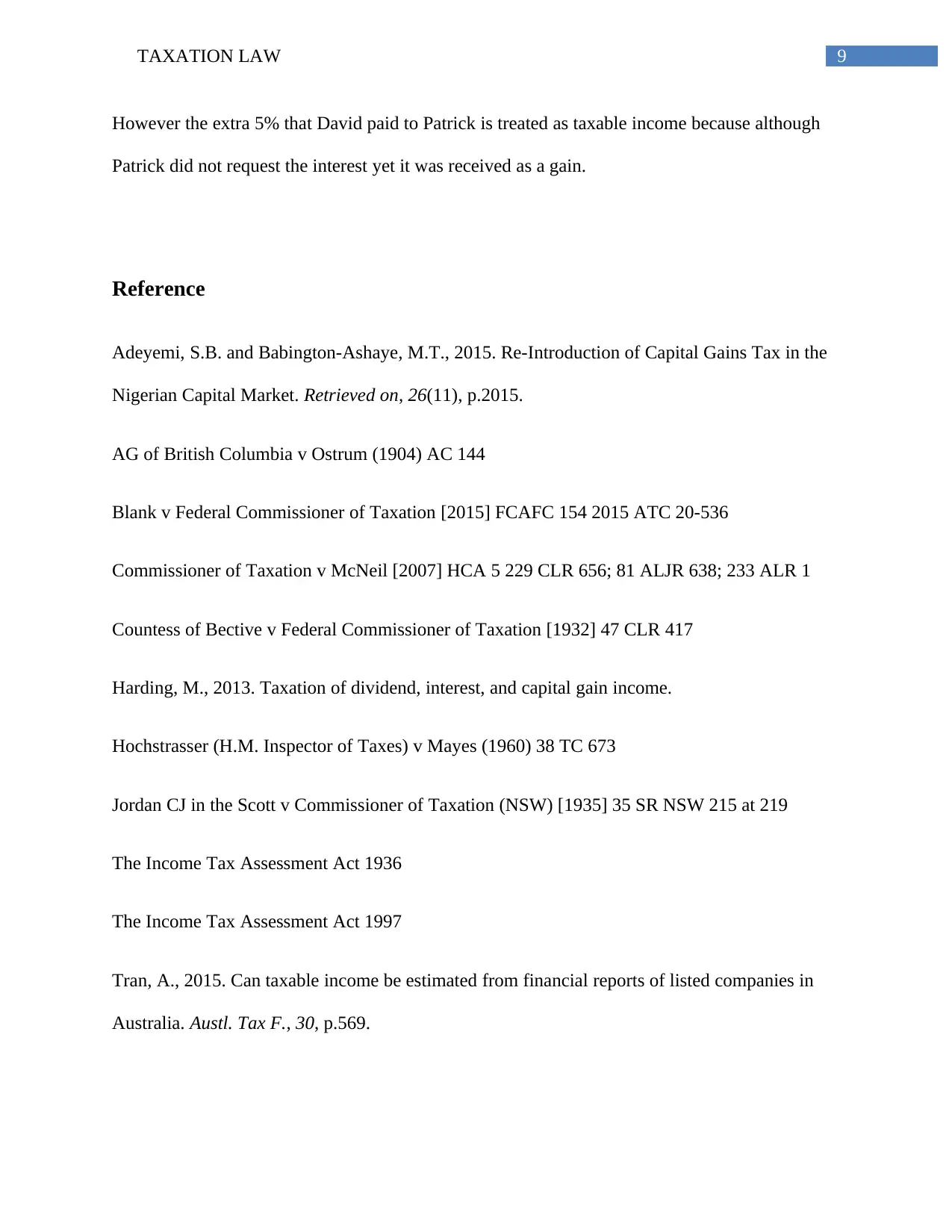
9TAXATION LAW
However the extra 5% that David paid to Patrick is treated as taxable income because although
Patrick did not request the interest yet it was received as a gain.
Reference
Adeyemi, S.B. and Babington-Ashaye, M.T., 2015. Re-Introduction of Capital Gains Tax in the
Nigerian Capital Market. Retrieved on, 26(11), p.2015.
AG of British Columbia v Ostrum (1904) AC 144
Blank v Federal Commissioner of Taxation [2015] FCAFC 154 2015 ATC 20-536
Commissioner of Taxation v McNeil [2007] HCA 5 229 CLR 656; 81 ALJR 638; 233 ALR 1
Countess of Bective v Federal Commissioner of Taxation [1932] 47 CLR 417
Harding, M., 2013. Taxation of dividend, interest, and capital gain income.
Hochstrasser (H.M. Inspector of Taxes) v Mayes (1960) 38 TC 673
Jordan CJ in the Scott v Commissioner of Taxation (NSW) [1935] 35 SR NSW 215 at 219
The Income Tax Assessment Act 1936
The Income Tax Assessment Act 1997
Tran, A., 2015. Can taxable income be estimated from financial reports of listed companies in
Australia. Austl. Tax F., 30, p.569.
However the extra 5% that David paid to Patrick is treated as taxable income because although
Patrick did not request the interest yet it was received as a gain.
Reference
Adeyemi, S.B. and Babington-Ashaye, M.T., 2015. Re-Introduction of Capital Gains Tax in the
Nigerian Capital Market. Retrieved on, 26(11), p.2015.
AG of British Columbia v Ostrum (1904) AC 144
Blank v Federal Commissioner of Taxation [2015] FCAFC 154 2015 ATC 20-536
Commissioner of Taxation v McNeil [2007] HCA 5 229 CLR 656; 81 ALJR 638; 233 ALR 1
Countess of Bective v Federal Commissioner of Taxation [1932] 47 CLR 417
Harding, M., 2013. Taxation of dividend, interest, and capital gain income.
Hochstrasser (H.M. Inspector of Taxes) v Mayes (1960) 38 TC 673
Jordan CJ in the Scott v Commissioner of Taxation (NSW) [1935] 35 SR NSW 215 at 219
The Income Tax Assessment Act 1936
The Income Tax Assessment Act 1997
Tran, A., 2015. Can taxable income be estimated from financial reports of listed companies in
Australia. Austl. Tax F., 30, p.569.
Paraphrase This Document
Need a fresh take? Get an instant paraphrase of this document with our AI Paraphraser

10TAXATION LAW
Wilkins, R., 2015. Measuring income inequality in Australia. Australian Economic
Review, 48(1), pp.93-102.
Wilkins, R., 2015. Measuring income inequality in Australia. Australian Economic
Review, 48(1), pp.93-102.
1 out of 11
Related Documents
Your All-in-One AI-Powered Toolkit for Academic Success.
+13062052269
info@desklib.com
Available 24*7 on WhatsApp / Email
![[object Object]](/_next/static/media/star-bottom.7253800d.svg)
Unlock your academic potential
Copyright © 2020–2025 A2Z Services. All Rights Reserved. Developed and managed by ZUCOL.




